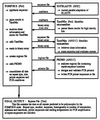Computerized polymorphic marker identification: experimental validation and a predicted human polymorphism catalog
- PMID: 9636181
- PMCID: PMC22669
- DOI: 10.1073/pnas.95.13.7514
Computerized polymorphic marker identification: experimental validation and a predicted human polymorphism catalog
Abstract
A computational system for the prediction of polymorphic loci directly and efficiently from human genomic sequence was developed and verified. A suite of programs, collectively called POMPOUS (polymorphic marker prediction of ubiquitous simple sequences) detects tandem repeats ranging from dinucleotides up to 250 mers, scores them according to predicted level of polymorphism, and designs appropriate flanking primers for PCR amplification. This approach was validated on an approximately 750-kilobase region of human chromosome 3p21.3, involved in lung and breast carcinoma homozygous deletions. Target DNA from 36 paired B lymphoblastoid and lung cancer lines was amplified and allelotyped for 33 loci predicted by POMPOUS to be variable in repeat size. We found that among those 36 predominately Caucasian individuals 22 of the 33 (67%) predicted loci were polymorphic with an average heterozygosity of 0.42. Allele loss in this region was found in 27/36 (75%) of the tumor lines using these markers. POMPOUS provides the genetic researcher with an additional tool for the rapid and efficient identification of polymorphic markers, and through a World Wide Web site, investigators can use POMPOUS to identify polymorphic markers for their research. A catalog of 13,261 potential polymorphic markers and associated primer sets has been created from the analysis of 141,779,504 base pairs of human genomic sequence in GenBank. This data is available on our Web site (pompous.swmed.edu) and will be updated periodically as GenBank is expanded and algorithm accuracy is improved.
Figures


Similar articles
-
Genome-wide simple sequence repeats (SSR) markers discovered from whole-genome sequence comparisons of multiple spinach accessions.Sci Rep. 2021 May 11;11(1):9999. doi: 10.1038/s41598-021-89473-0. Sci Rep. 2021. PMID: 33976335 Free PMC article.
-
pSTR Finder: a rapid method to discover polymorphic short tandem repeat markers from whole-genome sequences.Investig Genet. 2015 Aug 5;6:10. doi: 10.1186/s13323-015-0027-x. eCollection 2015. Investig Genet. 2015. PMID: 26246889 Free PMC article.
-
Linkage mapping by simultaneous screening of multiple polymorphic loci using Alu oligonucleotide-directed PCR.Proc Natl Acad Sci U S A. 1992 Sep 15;89(18):8448-51. doi: 10.1073/pnas.89.18.8448. Proc Natl Acad Sci U S A. 1992. PMID: 1528850 Free PMC article.
-
Efficient development of highly polymorphic microsatellite markers based on polymorphic repeats in transcriptome sequences of multiple individuals.Mol Ecol Resour. 2015 Jan;15(1):17-27. doi: 10.1111/1755-0998.12289. Epub 2014 Jun 28. Mol Ecol Resour. 2015. PMID: 24893879
-
Involvement of the multiple tumor suppressor genes and 12-lipoxygenase in human prostate cancer. Therapeutic implications.Adv Exp Med Biol. 1997;407:41-53. doi: 10.1007/978-1-4899-1813-0_7. Adv Exp Med Biol. 1997. PMID: 9321930 Review.
Cited by
-
Molecular origins of rapid and continuous morphological evolution.Proc Natl Acad Sci U S A. 2004 Dec 28;101(52):18058-63. doi: 10.1073/pnas.0408118101. Epub 2004 Dec 13. Proc Natl Acad Sci U S A. 2004. PMID: 15596718 Free PMC article.
-
Repeat polymorphisms within gene regions: phenotypic and evolutionary implications.Am J Hum Genet. 2000 Aug;67(2):345-56. doi: 10.1086/303013. Epub 2000 Jul 7. Am J Hum Genet. 2000. PMID: 10889045 Free PMC article.
-
A long AAAG repeat allele in the 5' UTR of the ERR-γ gene is correlated with breast cancer predisposition and drives promoter activity in MCF-7 breast cancer cells.Breast Cancer Res Treat. 2011 Nov;130(1):41-8. doi: 10.1007/s10549-010-1237-9. Epub 2010 Dec 10. Breast Cancer Res Treat. 2011. PMID: 21153485 Free PMC article.
-
Exact tandem repeats analyzer (E-TRA): a new program for DNA sequence mining.J Genet. 2005 Apr;84(1):49-54. doi: 10.1007/BF02715889. J Genet. 2005. PMID: 15876583
-
Global microsatellite content distinguishes humans, primates, animals, and plants.Mol Biol Evol. 2009 Dec;26(12):2809-19. doi: 10.1093/molbev/msp192. Epub 2009 Aug 28. Mol Biol Evol. 2009. PMID: 19717526 Free PMC article.
References
-
- Dib C, Fauré S, Fizames C, Samson D, Drouot N, Vignal A, Millasseau P, Marc S, Hazan J, Seboun E, et al. Nature (London) 1996;38:152–154. - PubMed
-
- Chen H, Pulido J C, Duyk G M. Genomics. 1995;25:1–8. - PubMed
-
- Malo D, Vidal S M, Hu J, Skamene E, Gros P. Genomics. 1993;16:655–663. - PubMed
-
- Cornelis F, Hashimoto L, Loveridge J, MacCarthy A, Buckle V, Julier C, Bell J. Genomics. 1992;13:820–825. - PubMed
Publication types
MeSH terms
Substances
Grants and funding
LinkOut - more resources
Full Text Sources
Other Literature Sources

